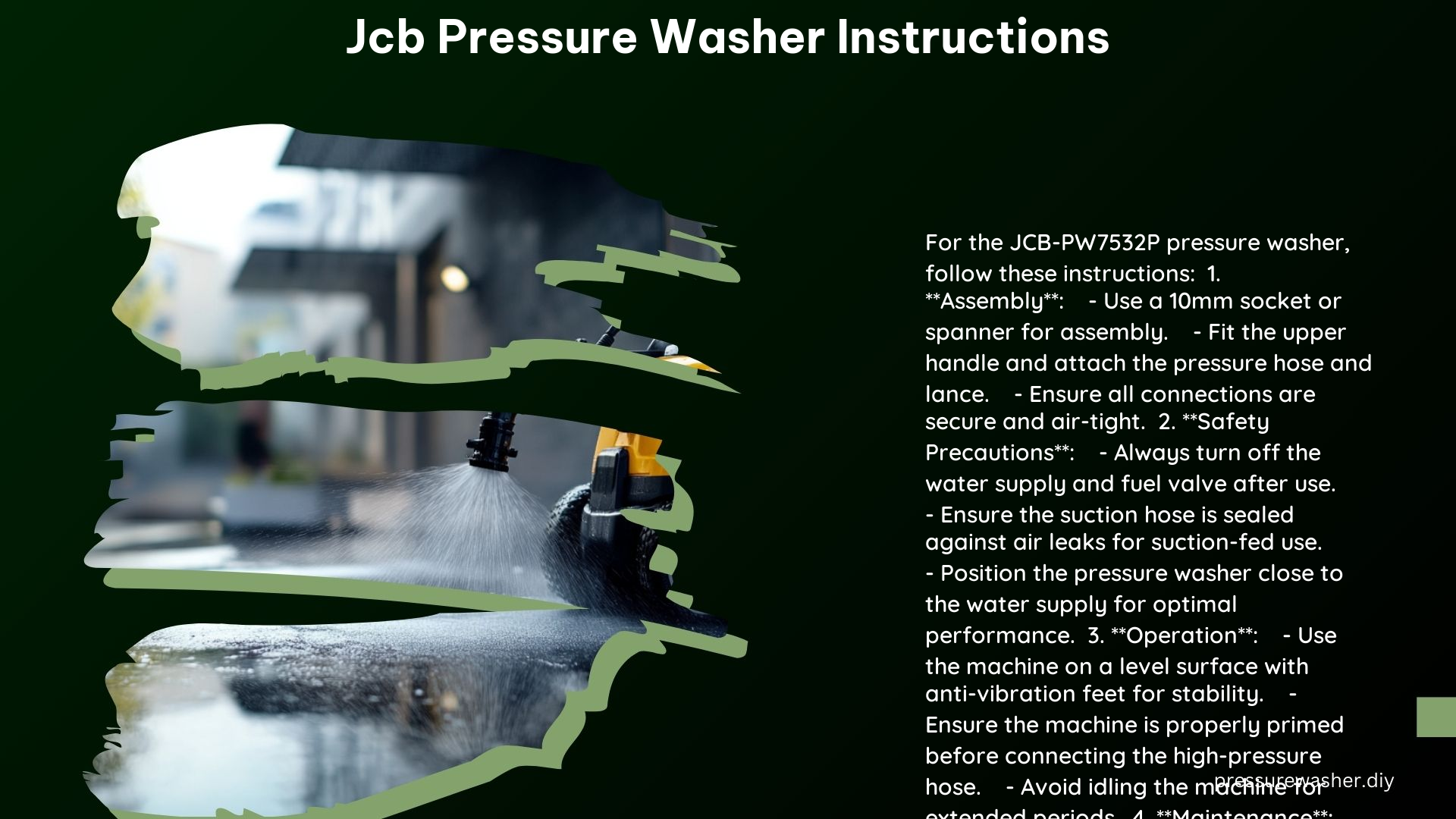Owning a JCB pressure washer can be a game-changer for your cleaning tasks, but to ensure its optimal performance, it’s crucial to follow the manufacturer’s instructions meticulously. This comprehensive guide will walk you through the step-by-step assembly, pre-operation checks, and proper usage of your JCB pressure washer, empowering you to tackle even the toughest cleaning challenges with ease.
Assembly
Frame Assembly
- Wheel Attachment: Secure the wheels to the frame using a 17mm washer and a 17mm nut. Ensure the cotter pin is firmly in place to prevent the wheel from detaching during operation.
- Rubber Feet: Attach the 50mm rubber feet to the frame’s bolts, securing them with a 17mm washer and a 17mm nut. These anti-vibration feet provide stability and reduce noise during operation.
Lance Assembly
- Lance Attachment: The lance is composed of two parts – the trigger gun and the wand. Firmly connect these two components, ensuring a secure and leak-proof connection.
- Nozzle Selection: The JCB pressure washer comes with a variety of nozzles (0°, 15°, 25°, and 40°) that offer different spray patterns. Choose the appropriate nozzle based on the cleaning task at hand.
Additional Components
- High-Pressure Hose: Attach the high-pressure hose to the pump outlet, ensuring a tight connection to prevent leaks.
- Water Inlet Fitting: Connect the water inlet fitting to the pressure washer’s water intake port, using the appropriate hose or fittings.
- Spark Plug Spanner: Locate the spark plug spanner provided with your JCB pressure washer, as it will be essential for engine maintenance tasks.
- Refer to User Manual: For detailed assembly instructions and any model-specific requirements, always consult the user manual supplied with your JCB pressure washer.
Pre-Operation Checks

Fuel Level
- Fuel Type: Use the recommended fuel type specified in the user manual for your JCB pressure washer model. Typically, a high-quality unleaded gasoline with an octane rating of 87 or higher is recommended.
- Fuel Level: Ensure the fuel tank is filled to the appropriate level before starting the engine. Refer to the user manual for the recommended fuel capacity.
Oil Level
- Oil Type: Use the engine oil type and viscosity recommended by the manufacturer. Common choices include SAE 10W-30 or SAE 10W-40 for four-stroke engines.
- Oil Level Checking: Regularly check the engine oil level using the dipstick. Top up the oil if necessary, but do not overfill.
- Oil Change Interval: Follow the recommended oil change schedule outlined in the user manual to maintain optimal engine performance and longevity.
Air Filter
- Air Filter Inspection: Visually inspect the air filter for any signs of damage or excessive dirt buildup. A clogged or damaged air filter can impair engine performance.
- Air Filter Replacement: Replace the air filter if it appears heavily soiled or damaged. Consult the user manual for the recommended replacement interval.
Operation
Starting
- Fuel Valve: Ensure the fuel valve is in the “ON” position before attempting to start the engine.
- Starting Procedure: Refer to the user manual for the specific starting procedure for your JCB pressure washer model. This typically involves setting the choke, engaging the throttle, and pulling the recoil starter.
Pressure Washing
- Pressure and Flow Rate: Use the pressure washer within the recommended pressure and flow rate range specified in the user manual. Exceeding these limits can damage the pump or other components.
- Idling: Avoid prolonged idling of the engine, as it can lead to premature wear and tear on the pump and other components.
Stopping
- Fuel Valve: After completing your pressure washing tasks, turn the fuel valve to the “OFF” position.
- Cooling: Allow the engine to cool down before storing the pressure washer. This helps prevent potential damage to the engine and other components.
Troubleshooting
Engine Issues
- Troubleshooting Guide: Refer to the troubleshooting section in the user manual for common engine-related issues and their corresponding solutions.
- Maintenance and Repair: For more complex engine problems or if you’re unsure of the root cause, consult a qualified service technician or the JCB Tools customer support team.
Pump Issues
- Air Leaks: Check the suction hose for any air leaks that could prevent the pump from properly priming and building pressure.
- Priming the Pump: Ensure the pump is properly primed before starting the pressure washer. Refer to the user manual for the recommended priming procedure.
Technical Specifications
- Frame: Robust, 32mm tubular steel frame with a soft-grip handle for enhanced user comfort and control.
- Pump: High-pressure axial cam pump with a water inlet and high-pressure outlet, capable of delivering up to 2,800 PSI (193 bar) of pressure.
- Tyres: Tough, puncture-proof 8-inch pneumatic tires for easy maneuverability on various surfaces.
- Feet: 50mm anti-vibration rubber feet that provide stability and reduce noise during operation.
Additional Resources
User Manuals
Comprehensive user manuals for JCB pressure washers are available in multiple languages on the JCB Tools website. These manuals provide detailed instructions, troubleshooting guides, and technical specifications for your specific model.
Instruction Videos
Unboxing and assembly videos for JCB pressure washers can be found on the JCB Tools YouTube channel, offering visual guidance for the setup process.
References
- JCB-PW7532P Instructions & User’s Manual – ManualsLib
- JCB-PW7532P – Product Downloads by FreshClick
- JCB-PW8TSS Pressure Washer Instruction Manual – Internet Archive
- Unboxing and Setting up a Brand New JCB Petrol Pressure Washer – YouTube
- User Manuals – JCB Tools
By following the detailed instructions and guidelines outlined in this comprehensive guide, you can ensure the optimal performance and longevity of your JCB pressure washer. Remember to always refer to the user manual for model-specific requirements and consult the JCB Tools customer support team if you have any further questions or concerns.
